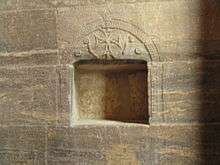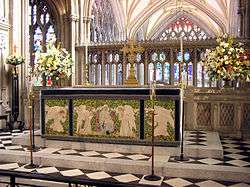Altar
An altar is a structure upon which offerings such as sacrifices are made for religious purposes. Altars are found at shrines, temples, churches and other places of worship. They are used particularly in Pagan, Christianity, Buddhism, Hinduism, Judaism (until the destruction of the Second Temple), and Modern Paganism. Many historical faiths also made use of them, including Roman, Greek, and Norse religion.
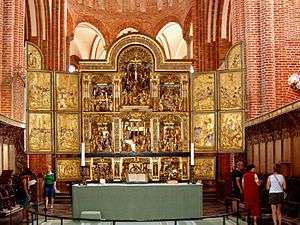
Etymology
Old English had various spellings alter, altar etc. Finally "altar" may have been influenced by the French autel derived from Latin words altare meaning podium or stage and adolere to adore, in this sense meaning to worship, honour and offer sacrifices to influence forces beyond human understanding.[1] [2]
Altars in antiquity
- Altars in antiquity
- Horned altar at Tel Be'er Sheva, Israel.
 Ancient Greek kylix showing a hoplite offering a sacrifice before an altar, around 480 BC. Ancient Agora Museum of Athens in the Stoa of Attalus
Ancient Greek kylix showing a hoplite offering a sacrifice before an altar, around 480 BC. Ancient Agora Museum of Athens in the Stoa of Attalus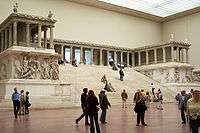 The ancient Altar of Pergamon, reconstructed at the Pergamon museum, Berlin.
The ancient Altar of Pergamon, reconstructed at the Pergamon museum, Berlin.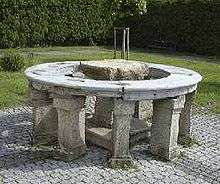 The Opferstein or Sacrifice Rock at Maria Taferl, Austria. It was used by the ancient Celts to make sacrifices upon and is now located in the plaza of the basilica there.
The Opferstein or Sacrifice Rock at Maria Taferl, Austria. It was used by the ancient Celts to make sacrifices upon and is now located in the plaza of the basilica there.
Judaism
Altars (Hebrew: מזבח, mizbe'ah, "a place of slaughter or sacrifice")[3] in the Hebrew Bible were typically made of earth[4] or unwrought stone.[5] Altars were generally erected in conspicuous places.[6][7][8][9] The first altar recorded in the Hebrew Bible is that erected by Noah.[10] Altars were erected by Abraham,[11] by Isaac,[12] by Jacob,[13] and by Moses.[14]
After the theophany on Mount Sinai, in the Tabernacle—and afterwards in the Temple—only two altars were used: the Altar of Burnt Offering, and the Altar of Incense.
Christianity

The word "altar", in Greek θυσιαστήριον (see:θυσία), appears twenty-four times in the New Testament. In Catholic and Orthodox Christian theology, the Eucharist is a re-presentation, in the literal sense of the one sacrifice being made "present again". Hence, the table upon which the Eucharist is consecrated is called an altar.
The altar plays a central role in the celebration of the Eucharist, which takes place at the altar on which the bread and the wine for consecration are placed. Altars occupy a prominent place in most Christian churches, both Eastern (Eastern Orthodoxy, Oriental Orthodoxy, the Assyrian Church of the East, and the Ancient Church of the East) and Western (the Roman Catholic Church, churches of the Anglican Communion, Methodists, Lutherans, and some Reformed) branches. Commonly among these churches, altars are placed for permanent use within designated places of communal worship (often called sanctuaries). Less often, though nonetheless notable, altars are set in spaces occupied less regularly, such as outdoors in nature, in cemeteries, in mausoleums/crypts, and family dwellings. Personal altars are those placed in a private bedroom, closet, or other space usually occupied by one person. They are used for practices of piety intended for one person (often referred to as a private devotion).They are also found in a minority of Protestant worship place; in Reformed and Anabaptist churches, a table, often called a "Communion table", serves an analogous function.

The area around the altar is seen as endowed with greater holiness, and is usually physically distinguished from the rest of the church, whether by a permanent structure such as an iconostasis, a rood screen, altar rails, a curtain that can be closed at more solemn moments of the liturgy (as in the Armenian Apostolic Church and Armenian Catholic Church), or simply by the general architectural layout. The altar is often on a higher elevation than the rest of the church.
Churches generally have a single altar, although in the Western branches of Christianity, as a result of the former abandonment of concelebration of Mass, so that priests always celebrated Mass individually, larger churches have had one or more side chapels, each with its own altar. The main altar was also referred to as the "high altar". Since the revival of concelebration in the West, the Roman Missal recommends that in new churches there should be only one altar, "which in the gathering of the faithful will signify the one Christ and the one Eucharist of the Church."[15] But most Western churches of an earlier period, whether Roman Catholic or Anglican, may have a high altar in the main body of the church, with one or more adjoining chapels, each with its own altar, at which the Eucharist may be celebrated on weekdays.
Architecturally, there are two types of altars: those that are attached to the eastern wall of the chancel, and those that are free-standing and can be walked around, for instance when incensing the altar.
In the earliest days of the Church, the Eucharist appears to have been celebrated on portable altars set up for the purpose. Some historians hold that, during the persecutions, the Eucharist was celebrated among the tombs in the Catacombs of Rome, using the sarcophagi (see sarcophagus) of martyrs as altars on which to celebrate. Other historians dispute this, but it is thought to be the origin of the tradition of placing relics beneath the altar.
When Christianity was legalized under Constantine the Great and Licinius, formal church buildings were built in great numbers, normally with free-standing altars in the middle of the sanctuary, which in all the earliest churches built in Rome was at the west end of the church. "When Christians in fourth-century Rome could first freely begin to build churches, they customarily located the sanctuary towards the west end of the building in imitation of the sanctuary of the Jerusalem Temple. Although in the days of the Jerusalem Temple the High Priest indeed faced east when sacrificing on Yom Kippur, the sanctuary within which he stood was located at the western end of the Temple. The Christian replication of the layout and the orientation of the Jerusalem Temple helped to dramatize the eschatological meaning attached to the sacrificial death of Jesus the High Priest in the Epistle to the Hebrews."[16] The ministers (bishop, priests, deacons, subdeacons, acolytes), celebrated the Eucharist facing east, towards the entrance. Some hold that for the central part of the celebration the congregation faced the same way. After the sixth century the contrary orientation prevailed, with the entrance to the west and the altar at the east end. Then the ministers and congregation all faced east during the whole celebration; and in Western Europe altars began, in the Middle Ages, to be permanently placed against the east wall of the chancel.
In Western Christian churches

Most rubrics, even in books of the seventeenth century and later, such as the Pontificale Romanum, continued to envisage the altar as free-standing. The rite of the Dedication of the Church[17] continued to presume that the officiating Bishop could circle the altar during the consecration of the church and its altar. Despite this, with the increase in the size and importance of the reredos, most altars were built against the wall or barely separated from it.
In almost all cases, the eastward orientation for prayer was maintained, whether the altar was at the west end of the church, as in all the earliest churches in Rome, in which case the priest celebrating Mass faced the congregation and the church entrance, or whether it was at the east end of the church, in which case the priest faced the eastern apse and had his back to the congregation. This diversity was recognized in the rubrics of the Roman Missal from the 1604 typical edition of Pope Clement VIII to the 1962 edition of Pope John XXIII: "Si altare sit ad orientem, versus populum ..."[18]
When placed close to a wall or touching it, altars were often surmounted by a reredos or altarpiece. If free-standing, they could be placed, as also in Eastern Christianity, within a ciborium (sometimes called a baldachin).
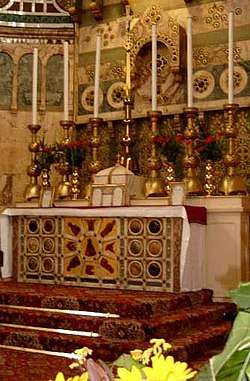
The rules regarding the present-day form of the Roman Rite liturgy declare a free-standing main altar to be "desirable wherever possible."[19] Similarly, in the Anglican Communion, the rubrics of the Book of Common Prayer assumed an altar fixed against the wall, until Prayer Book revision in the twentieth century removed language which assumed any particular form of altar.
As well as altars in the structural sense, it became customary in the West to have what in Latin were referred to as altaria portatilia (portable altars), more commonly referred to in English as "altar stones". When travelling, a priest could take one with him and place it on an ordinary table for saying Mass. They were also inserted into the centre of structural altars especially those made of wood. In that case, it was the altar stone that was considered liturgically to be the altar. The Pontificale Romanum contained a rite for blessing at the same time several of these altar stones.[20] In the East the antimension served and continues to serve the same purpose.
The term "movable altar" or "portable altar" is now used of a full-scale structural altar, with or without an inserted altar stone, that can be moved.[21]
Movable altars include the free-standing wooden tables without altar stone, placed in the choir away from the east wall, favoured by churches in the Reformed tradition. Altars that not only can be moved but are repeatedly moved are found in low church traditions that do not focus worship on the Eucharist, celebrating it rarely. Both Catholics and Protestants celebrate the Eucharist at such altars outside of churches and chapels, as outdoors or in an auditorium.
Catholic Church
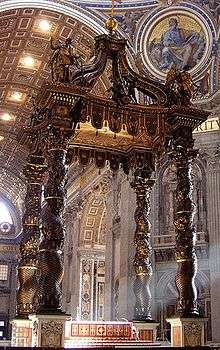
The Eastern Catholic Churches each follow their own traditions, which in general correspond to those of similar Eastern Orthodox or Oriental Orthodox Churches. All Christian Churches see the altar on which the Eucharist is offered as the "table of the Lord" (trapeza Kyriou) of Saint Paul's 1 Corinthians 10:21. The rules indicated here are those of the Latin Church.
The Latin Church distinguishes between fixed altars (those attached to the floor) and movable altars (those that can be displaced), and states: "It is desirable that in every church there be a fixed altar, since this more clearly and permanently signifies Christ Jesus, the Living Stone (1 Peter 2:4; cf. Ephesians 2:10). In other places set aside for sacred celebrations, the altar may be movable."[22]
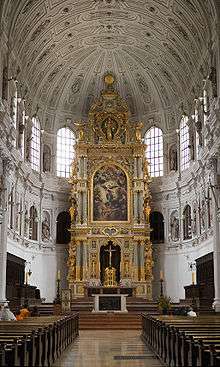
A fixed altar should in general be topped by a slab of natural stone, thus conforming to tradition and to the significance attributed to the altar, but in many places dignified, well-crafted solid wood is permitted; the supports or base of a fixed altar may be of any dignified solid material. A movable altar may be of any noble solid material suitable for liturgical use.[23]
The liturgical norms state:
- It is fitting that the tradition of the Roman liturgy should be preserved of placing relics of martyrs or other saints beneath the altar. However, the following should be noted:
- a) Relics intended for deposition should be of such a size that they can be recognized as parts of human bodies. Hence excessively small relics of one or more saints must not be deposited.
- b) The greatest care must be taken to determine whether relics intended for deposition are authentic. It is better for an altar to be dedicated without relics than to have relics of doubtful credibility placed beneath it.
- c) A reliquary must not be placed on the altar or in the table of the altar but beneath the table of the altar, as the design of the altar may allow.[24]
This last norm explicitly excludes the practice customary in recent centuries of inserting relics into a specially created cavity within the table of an altar or altar stone. Placing of relics even in the base of a movable altar is also excluded.[25]
"In building new churches, it is preferable for a single altar to be erected, one that in the gathering of the faithful will signify the one Christ and the one Eucharist of the Church. In already existing churches, however, when the old altar is so positioned that it makes the people's participation difficult but cannot be moved without damage to artistic value, another fixed altar, skillfully made and properly dedicated, should be erected and the sacred rites celebrated on it alone. In order that the attention of the faithful not be distracted from the new altar the old altar should not be decorated in any special way."[26]
The altar, fixed or movable, should as a rule be separate from the wall so as to make it easy to walk around it and to celebrate Mass at it facing the people. It should be positioned so as to be the natural centre of attention of the whole congregation.[27]
The altar should be covered by at least one white cloth, and nothing else should be placed upon the altar table other than what is required for the liturgical celebration. Candlesticks and a crucifix, when required, can be either on the altar or near it, and it is desirable that the crucifix remain even outside of liturgical celebrations.[28]
Protestant churches

A wide variety of altars exist in various Protestant denominations. Some Churches, such as the Lutheran, have altars very similar to Anglican or Catholic ones keeping with their more sacramental understanding of the Lord's Supper. Calvinist churches from Reformed, Baptist, Congregational, and Non-denominational backgrounds instead have a Communion Table adorned with a linen cloth, as well as an open Bible and a pair of candlesticks; it is not referred to as an "altar" because they do not see Holy Communion as sacrificial in any way.[29] Such a table may be temporary, being moved into place only when there is a Communion Service.[30] Some nondenominational churches have no altar or communion table, even if they retain the practice of the "altar call" that originated in the Methodist Church.[31][32][33]

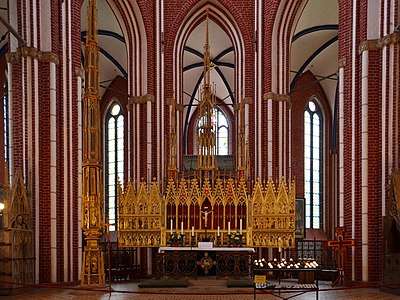
Some Methodist and other evangelical churches practice what is referred to as an altar call, whereby those who wish to make a new spiritual commitment to Jesus Christ are invited to come forward publicly.[34] It is so named because the supplicants, at the end of the sermon, kneel at the altar rails, which are located around the altar within chancel.[35] Those that come forward will often recite a sinner's prayer, which, in evangelical understanding, if truly heart-felt indicates that they are now "saved". They may also be offered religious literature, counselling or other assistance. Many times it is said that those who come forth are going to "be saved". This is a ritual in which the supplicant makes a prayer of penitence (asking for his sins to be forgiven) and faith (called in evangelical Christianity "accepting Jesus Christ as their personal Lord and Saviour").
Lutheran churches
Altars in Lutheran churches are often similar to those in Roman Catholic and Anglican churches. Lutherans believe that the altar represents Christ and should only be used to consecrate and distribute the Eucharist.[36] Lutheran altars are commonly made out of granite, but other materials are also used. A crucifix is to be put above the altar.[36] Sometimes relics are also placed around the altar.[37]
Anglican churches
Altars in the Anglican Communion vary widely. In the Book of Common Prayer, the basis of doctrine and practice for the Church of England, there is no use of the word 'altar'; the item in question is called 'the Lord's Table' or 'Holy Table'. This remains the official terminology, though common usage may call the communion table an altar.
At the time of the Reformation, altars were fixed against the east end of the church, and the priests would celebrate the Mass standing at the front of the altar. Beginning with the rubrics of the Second Prayer Book of Edward VI published in 1552, and through the 1662 Book of Common Prayer (which prevailed for almost 300 years), the priest is directed to stand "at the north syde of the Table." This was variously interpreted over the years to mean the north side of the front of a fixed communion table, the north end of a fixed table (i.e., facing south), the north side of a free-standing table (presumably facing those intending to receive the Elements who would be sitting in the quire stalls opposite), or at the north end of a free-standing table lengthwise in the chancel, facing a congregation seated in the nave.
Often, where a celebrant chose to situate himself was meant to convey his churchmanship (that is, more Reformed or more Catholic). The use of candles or tabernacles was banned by canon law, with the only appointed adornment being a white linen cloth.
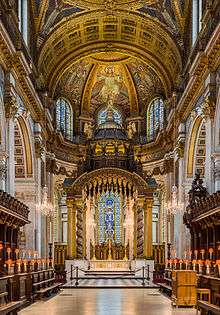
Beginning with the Oxford Movement in the 19th century, the appearance of Anglican altars took a dramatic turn in many churches. Candles and, in some cases, tabernacles were reintroduced. In some churches two candles, on each end of the altar, were used; in other cases six — three on either side of a tabernacle, typically surmounted by a crucifix or some other image of Christ.

In Anglican practice, conformity to a given standard depends on the ecclesiastical province and/or the liturgical sensibilities of a given parish. In the Parson's Handbook, an influential manual for priests popular in the early-to-mid-twentieth century, Percy Dearmer recommends that "All altars should be 3 ft. 3 in. high, and at least deep enough to take a corporal [the square of linen placed underneath the Communion vessels] 20 in. square, with an inch or two to spare." He also recommends that the altar stand upon three steps for each of the three sacred ministers, and that it be decorated with a silk frontal in the seasonal colour. In some cases, other manuals suggest that a stone be set in the top of wooden altars, in the belief that the custom be maintained of consecrating the bread and wine on a stone surface. In many other Anglican parishes, the custom is considerably less rigorous, especially in those parishes which use free-standing altars. Typically, these altars are made of wood, and may or may not have a solid front, which may or may not be ornamented. In many Anglican parishes, the use of frontals has persisted.
When altars are placed away from the wall of the chancel allowing a westward orientation, only two candles are placed on either end of it, since six would obscure the liturgical action, undermining the intent of a westward orientation (i.e., that it be visible to the congregation). In such an arrangement, a tabernacle may stand to one side of or behind the altar, or an aumbry may be used.
Sensibilities concerning the sanctity of the altar are widespread in Anglicanism. In some parishes, the notion that the surface of the altar should only be touched by those in holy orders is maintained. In others, there is considerably less strictness about the communion table. Nonetheless, the continued popularity of communion rails in Anglican church construction suggests that a sense of the sanctity of the altar and its surrounding area persists. In most cases, moreover, the practice of allowing only those items that have been blessed to be placed on the altar is maintained (that is, the linen cloth, candles, missal, and the Eucharistic vessels).
- Anglican churches
 The altar with ciborium at All Saints Anglican church, Bristol, England
The altar with ciborium at All Saints Anglican church, Bristol, England The Lord's Table in St Barnabas' Church, Dulwich (Diocese of Southwark)
The Lord's Table in St Barnabas' Church, Dulwich (Diocese of Southwark)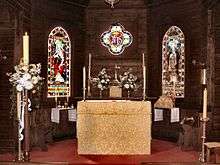 Altar in Bunyip, Victoria, Australia
Altar in Bunyip, Victoria, Australia- Altar at Grace Cathedral, San Francisco
.jpg) Altar at Anglo-Catholic Church of the Good Shepherd (Rosemont, Pennsylvania)
Altar at Anglo-Catholic Church of the Good Shepherd (Rosemont, Pennsylvania)
Eastern Christian Rites
Byzantine Rite
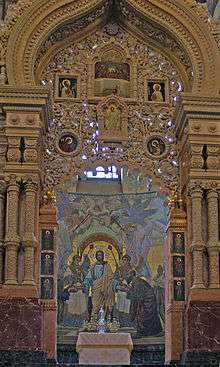
In Greek the word βωμός can mean an altar of any religion or, in a broader sense, the area surrounding it; that is to say, the entire sanctuary.[38] In an Eastern Orthodox or a Byzantine Rite Eastern Catholic church this sanctuary includes both the area behind the iconostasis, and the soleas (the elevated projection in front of the iconostasis), and the ambo. It is also called the βῆμα (bema). When one enters the sanctuary, one is said to be going into the βωμός or βῆμα. The altar itself in such a church may be referred to as either the Holy Table (Greek Ἁγία Τράπεζα) or the Throne (chu Prestól).
For both Eastern Orthodox and Byzantine Eastern Catholics, the Holy Table (altar) is normally free-standing, although in very small sanctuaries it might be placed flush against the back wall for reasons of space. They are typically about one meter high, and although they may be made of stone they are generally built out of wood. The exact dimensions may vary, but it is generally square in plan and in reasonable proportion to the size of the sanctuary. It has five legs: one at each corner plus a central pillar for supporting the relics which are placed in it at its consecration (if, however, the consecration was not performed by a bishop, but by a priest whom he delegated for that purpose, relics are not placed in the Holy Table). A plain linen covering (Greek: Katasarkion, Slavonic: Strachítsa) is bound to the Holy Table with cords; this cover is never removed after the altar is consecrated, and is considered to be the "baptismal garment" of the altar. The linen covering symbolizes the winding sheet in which the body of Christ was wrapped when he was laid in the tomb. Since the altar is never seen uncovered thereafter, the table tends to be constructed more with sturdiness than aesthetics in mind. Above this first cover is a second ornamented altar cloth (Indítia), often in a brocade of a liturgical color that may change with the ecclesiastical season. This outer covering usually comes all the way to the floor and represents the glory of God's Throne.[39] In many churches it is the custom for a dust cover to be placed on the Holy Table between services. This is often a simple red cloth, though it may be made of richer stuff. Sometimes it covers only the Gospel Book or the front half of the Holy Table, but it may be large enough to cover the entire Holy Table and everything on it, including candlesticks and the seven-branch candelabra.
_14.jpg)
Atop the altar is the tabernacle (Kovtchég), a miniature shrine sometimes built in the form of a church, inside of which is a small ark containing the Reserved sacrament for use in communing the sick. Also kept on the altar is the Gospel Book. Under the Gospel is kept the antimension, a silken cloth imprinted with an icon of Christ being prepared for burial, which has a relic sewn into it and bears the signature of the bishop. Another, simpler cloth, the ilitón, is wrapped around the antimension to protect it, and symbolizes the "napkin" that was tied around the face of Jesus when he was laid in the tomb (forming a companion to the strachitsa). The Divine Liturgy must be served on an antimension even if the altar has been consecrated and contains relics. When not in use, the antimension is left in place in the center of the Holy Table and is not removed except for necessity.
The Holy Table may only be touched by ordained members of the higher clergy (bishops, priests and deacons), and nothing which is not itself consecrated or an object of veneration should be placed on it. Objects may also be placed on the altar as part of the process for setting them aside for sacred use. For example, icons are usually blessed by laying them on the Holy Table for a period of time or for a certain number of Divine Liturgies before sprinkling them with holy water, and placing them where they will be venerated. The Epitaphios on Good Friday, and the Cross on the Feasts of the Cross, are also placed on the Holy Table before they are taken to the center of the church to be venerated by the faithful.
In place of the outer covering, some altars have a permanent solid cover which may be highly ornamented, richly carved, or even plated in precious metals. A smaller brocade cover is used on top of this if it is desired that the altar decoration reflect the liturgical season.
The Holy Table is used as the place of offering in the celebration of the Eucharist, where bread and wine are offered to God the Father and the Holy Spirit is invoked to make his Son Jesus Christ present in the Gifts. It is also the place where the presiding clergy stand at any service, even where no Eucharist is being celebrated and no offering is made other than prayer. When the priest reads the Gospel during Matins (or All-Night Vigil) on Sunday, he reads it standing in front of the Holy Table, because it represents the Tomb of Christ, and the Gospel lessons for Sunday Matins are always one of the Resurrection appearances of Jesus.
On the northern side of the sanctuary stands another, smaller altar, known as the Table of Oblation (Prothesis or Zhértvennik) at which the Liturgy of Preparation takes place. On it the bread and wine are prepared before the Divine Liturgy. The Prothesis symbolizes the cave of Bethlehem and also the Anointing stone at which the Body of Christ was prepared after the Deposition from the Cross. The Table of Oblation is also blessed, sprinkled with holy water and vested at the consecration of a church, but there are no relics placed in it. Nothing other than the sacred vessels, veils, etc. which are used in the Liturgy of Preparation may be placed on the Table of Oblation. The Epitaphios and Cross are also placed on the Table of Oblation before the priest and deacon solemnly transfer them to the Holy Table. In addition to the higher clergy, subdeacons are permitted to touch the Table of Oblation, but no one of lesser rank may do so. The Table of Oblation is the place where the deacon will consume the remaining Gifts (Body and Blood of Christ) after the Divine Liturgy and perform the ablutions.
Syro-Maronite Church
The Syriac Maronite Church, along with the other Syriac Churches, has freestanding altars in most cases so the priests and deacons can circumambulate the altar during processions and incensations. Traditionally the Maronite liturgy was offered with the priest and people oriented to the East but because of modern latinizations it is common to find Maronite liturgies offered with the priest facing against the people from the opposite side of the altar, in imitation of modern practices in the Latin Church.
Oriental Rites
Armenian Rite
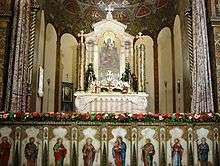
In the Armenian Rite the altar is placed against the eastern wall of the church, often in an apse. The shape of the altar is usually rectangular, similar to Latin altars, but is unusual in that it will normally have several steps on top of the table, on which are placed the tabernacle, candles, ceremonial fans, a cross, and the Gospel Book. The altar is often located upon a kind of stage above a row of icons.
Alexandrian Rite
Altars in the Alexandrian (Coptic Orthodox Church) tradition must have a square face upon which to offer the sacrifice. As the standard Coptic liturgy requires the priest to encircle the altar, it is never attached to any wall. Most Coptic altars are located under a baldachin.
Ethiopic Rite
In Ethiopian Orthodox Church tradition an icon is placed upon but towards the rear of the altar. It is away from the wall as in the Coptic tradition.
West Syriac Rite
Syriac churches have altars.
East Syriac
Altars of East Syriac Rite are similar in appearance to Armenian altars only they are not placed on a stage.
Indian Rites
Altars are often heavily decorated in the Indian tradition.
War altar
A war altar was a mobile altar on which Mass was celebrated before a battle. The ultimate example is the carroccio of the medieval Italian city states, which was a four-wheeled mobile shrine pulled by oxen and sporting a flagpole and a bell. The carroccio also served as the army standard.
Altar stones were used by army chaplains of the Latin Church in the period leading up to the 20th century.
Hinduism
In Hinduism, altars generally contain pictures or statues of gods and goddesses. Large, ornate altars are found in Hindu temples while smaller altars are found in homes and sometimes also in Hindu-run shops and restaurants. The word for temple is mandir (san: मन्दिर), the altar (and that which contains it, even an alcove or a small cabinet) as hypostatised temple.
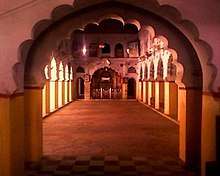
In South Indian temples, often each god will have His or Her own shrine, each contained in a miniature house (specifically, a mandir). These shrines are often scattered around the temple compound, with the three main ones being in the main area. The statue of the God (murti) is placed on a stone pedestal in the shrine, and one or more lamps are hung in the shrine. There is usually a space to put the puja tray (tray with worship offerings). Directly outside the main shrine there will be a statue of the god's vahana or vehicle. The shrines have curtains hung over the entrances, and wooden doors which are shut when the Deities are sleeping. Some South Indian temples have one main altar, with several statues placed upon it.
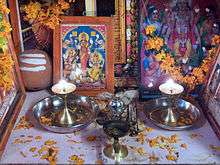
North Indian temples generally have one main altar at the front of the temple room. In some temples, the front of the room is separated with walls and several altars are placed in the alcoves. The statues on the altars are usually in pairs, each god with his consort (Radha-Krishna, Sita-Rama, Shiva-Parvati). However, some gods, such as Ganesha and Hanuman, are placed alone. Ritual items such as flowers or lamps may be placed on the altar.
Home shrines can be as simple or as elaborate as the householder can afford. Large, ornate shrines can be purchased in India and countries with large Hindu minorities, like Malaysia and Singapore. They are usually made of wood and have tiled floors for statues to be placed upon. Pictures may be hung on the walls of the shrine. The top of the shrine may have a series of levels, like a gopuram tower on a temple. Each Hindu altar will have at least one oil lamp and may contain a tray with puja equipment as well. Hindus with large houses will set aside one room as their puja room, with the altar at one end of it. Some South Indians also place a shrine with pictures of their departed relatives on the right side of the room, and make offerings to them before making offerings to the gods.
See also: Vedi (altar) and Homa (ritual)
Taoism

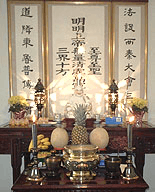
Taoist altars are erected to honor traditional deities and the spirits of ancestors. Taoist altars may be erected in temples or in private homes. Strict traditions describe the items offered and the ritual involved in the temples, but folk custom in the homes is much freer.
Imperial dynasties built huge altars called jìtán (祭坛) to perform various offering ceremonies called jìsì (祭祀). The Temple of Heaven in Beijing is one of those.
Nearly all forms of Chinese traditional religion involve baibai (拜拜)--bowing towards an altar, with a stick of incense in one's hand.[40] (Some schools prescribe the use of three sticks of incense in the hand at one time.[41]) This may be done at home, or in a temple, or outdoors; by an ordinary person, or a professional (such as a Taoist priest); and the altar may feature any number of deities or ancestral tablets. Baibai is usually done in accordance with certain dates of the lunar/solar calendar (see Chinese calendar).
At certain dates, food may be set out as a sacrifice to the gods and/or spirits of the departed. (See, for example, Qingming Festival and Ghost Festival.) This may include rice, slaughtered pigs and ducks, or fruit. Another form of sacrifice involves the burning of Hell Bank Notes, on the assumption that images thus consumed by the fire will reappear—not as a mere image, but as the actual item—in the spirit world, and be available for the departed spirit to use. In Taoist folk religion, sometimes chickens, pigs feet, and pig heads are given as offerings. But in orthodox Daoist practice, offerings should essentially be incense, candles and vegetarian offerings.[42]
Buddhism
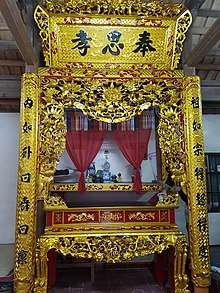
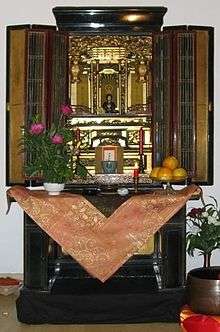
In Buddhist-following cultures, structures such as bàn thờ, butsudan or spirit house are found in temples or homes. The butsudan is a wooden cabinet with doors that enclose and protect a religious image of the Buddha or the Bodhisattvas (typically in the form of a statue) or a mandala scroll, installed in the highest place of honor and centered. The doors are opened to display the image during religious observances. A butsudan usually contains subsidiary religious items—called butsugu—such as candlesticks, incense burners, bells, and platforms for placing offerings such as fruit. Some buddhist sects place "ihai," memorial tablets for deceased relatives, within or near the butsudan. Butsudans are often decorated with flowers.
The shrine is placed in the temple or home as a place of worship to the Buddha, the Law of the Universe, etc. Scrolls (honzon) or statues are placed in the butsudan and prayed to morning and evening. Zen Buddhists also meditate before the butsudan.
The original design for the butsudan began in India, where people built altars as an offering-place to the Buddha. When Buddhism came to China and Korea, statues of the Buddha were placed on pedestals or platforms. The Chinese and Koreans built walls and doors around the statues to shield them from the weather. They could then safely offer their prayers, incense, etc. to the statue or scroll without it falling and breaking.
Shinto

In Shinto, altars are found in shrines. Originating in ancient times, himorogi are temporarily erected sacred spaces or "altars" used as a locus of worship. A physical area is demarcated with branches of green bamboo or sakaki at the four corners, between which are strung sacred border ropes (shimenawa). In the center of the area a large branch of sakaki festooned with sacred emblems (hei) is erected as a yorishiro, a physical representation of the presence of the kami and toward which rites of worship are performed.
In more elaborate cases, a himorogi may be constructed by placing a rough straw mat upon the ground, then erecting a ceremonial eight-legged stand (hakkyaku an) upon the mat and decorating the stand with a framework upon which are placed sacred border ropes and sacred border emblems. Finally the sakaki branch is erected in the center of this stand as the focus of worship.[43]
Norse paganism
A basic altar, called a Hörgr, was used for sacrifice in Norse paganism. The Hörgr was constructed of piled stones, possibly in a wood (harrow), and would be used in sacrifices and perhaps other ceremonies as well.
A possible use of the hörgr during a sacrifice would be to place upon it a bowl of the blood of an animal sacrificed to a Norse deity (e.g. a goat for Thor, a sow for Freyja, a boar for Freyr), then dipping a bundle of fir twigs into it and sprinkling the participants with the blood. This would consecrate the attendees to the ceremony, such as a wedding.
Asatru
In Nordic Modern Pagan practice, altars may be set up in the home or in wooded areas in imitation of the Hörgr of ancient times. They may be dedicated to Thor, Odin, or other Nordic deities.
Neopaganism
In Neopaganism there is a wide variety of ritual practice, running the gamut from a very eclectic Syncretism to strict Polytheistic reconstructionism. Many of these groups make use of altars. Some are constructed merely of rough-hewn or stacked stone, and some are made of fine wood or other finished material.
Wicca
Neo-Druidism
Modern Neo-Druidism may also make use of altars, often erected in groves. Though little is known of the specific religious beliefs and practices presided over by the ancient Druids, modern people who identify themselves as Druids are free to incorporate their imagination in developing ceremonies and the use of ritual objects in keeping with their belief system. The "Order of Common Worship" of the Liturgy of the Druids[44] (New Reformed Druids of North America) calls for a fire to be started "in or near the altar" and makes use of various objects such as a chalice, staves, and a plant offering. If no altar is used, the objects may be placed on the ground.
High places
High places are elevated areas on which altars have been erected for worship in the belief that, as they were nearer heaven than the plains and valleys, they are more favourable places for prayer. High places were prevalent in almost all ancient cultures as centers of cultic worship.
High places in Israelite (Hebrew: Bamah, or Bama) or Canaanite culture were open-air shrines, usually erected on an elevated site. Prior to the conquest of Canaan by the Israelites in the 12th–11th century BC, the high places served as shrines of the Canaanite fertility deities, the Baals (Lords) and the Asherot (Semitic goddesses). In addition to an altar, matzevot (stone pillars representing the presence of the divine) were erected.[45]
The practice of worship on these spots became frequent among the Hebrews, though after the temple was built it was forbidden. Such worship was with difficulty abolished, though denounced time after time by the prophets as an affront to God. A closely related example is a "backyard" altar, so to speak. Before there was a set temple and an established altar people built their own altars. After the temple was built use of these altars was forbidden. Unlike the previous case, "backyard" altar worship was quickly eradicated. In recent years, this practice has drastically decreased in popularity.
See also
- Altar candle
- Altar cards
- Altar Crucifix
- Altars in Latin America
- Altars in Roman Catholicism
- Analogion
- Ara Pacis
- Back-choir
- Cathedral diagram
- Credence table
- Dambana
- Ofrenda
- Predella
- Prothesis
- Sacrament
- Sacred architecture
- Winged altar
Notes
- Spanish etymology site
- Etymology online (English)
- "Altar", Encyclopedia Biblica, (1899).
- (Exodus 20:24)
- (20:25)
- (Genesis 22:9
- Ezekiel 6:3
- 2 Kings 23:12
- 16:423:8)
- (Genesis 8:20)
- (Genesis 12:7 13:4 22:9)
- (Genesis 26:25)
- (33:20 35:1-3)
- (Exodus 17:15
- General Instruction of the Roman Missal Archived July 20, 2008, at the Wayback Machine, 303
- The Biblical Roots of Church Orientation by Helen Dietz
- De ecclesiae dedicatione seu consacratione
- Ritus servandus Missae, V, 3
- General Instruction of the Roman Missal, 299.
- De altarium portatilium consecratione
- General Instruction of the Roman Missal, 298
- General Instruction of the Roman Missal (GIRM), 298
- GIRM, 301; canon 1236 of the Code of Canon Law
- Rite of Dedication of a Church and an Altar, Chapter II, 5; cf. GIRM, 302 and canon 1237 §2 of the Code of Canon Law
- Rite of Dedication of a Church and an Altar, Chapter VI, 4
- GIRM, 303
- GIRM, 299
- GIRM, 304-308
- Michael Keene, Christian Churches Nelson Thornes 2001 ISBN 978-0-7487-5288-1, p. 58
- Trinity Baptist Church Archived 2011-12-26 at the Wayback Machine
- Harvey Cox, Fire from Heaven (Da Capo Press 2001 ISBN 978-0-7867-3134-3), p. 274
- Elaine J. Lawless, God's Peculiar People (University of Kentucky 2005 ISBN 978-0-8131-9141-6), p. 57
- Gary Bouma, Australian Soul (Cambridge University Press 2006 ISBN 978-1-139-45938-9), p. 95
- Warren, Rick. "Communicating to Change Lives - Teaching Notes". Preaching for Life Change Seminar: International Version. p. 81.
The come forward invitation is a method that's only about 180 years old. It was invented by Methodist churches in the late 17th century and later picked up and popularized by Charles Finney in the mid-1800s—and the majority of evangelical churches use that form today.
- Goodwin, Alonzo T. (1977). Stories of Western Loggers. Loggers World. p. 88.
Every Methodist church has an altar rail below the pulpit platform where penitent folk can kneel and pray if they desire to seek divine help.
- Altar Guild and Sacristy Handbook by S. Anita Stauffer (Augsburg Fortress)
- LCMS vs. Catholic churches). Retrieved 2010-01-18
- Abbot Joseph, "The Byzantine Altar"
- Isabel Hapgood. Service Book of the Holy Orthodox-Catholic Apostolic Church (Antiochian Orthodox Christian Archdiocese, 1975), p. 614.
- Liu Zhongyu, "The Relationships between Confucianism, Buddhism, Taoism and Folk Custom", Journal Shijie Zongjiao, 1996: 24-32 (Regarding "baibai" as the term for the act of offering incense as a form of worship.)
- Silvers, Brock. The Taoist Manual (Honolulu: Sacred Mountain Press, 2005), p. 74
- Liu Zhong. "Burning Incense and Worshiping Spirits". Daoist Folk Customs. Translated by Lü Pengzhi. Taoist Culture and Information Centre. Archived from the original on 2007-09-29. Retrieved 2007-07-05.
- Kokugakuin University: Encyclopedia of Shinto
- Liturgy of the Druids
- "high place". Encyclopædia Britannica Online. 2007. Archived from the original on January 5, 2008. Retrieved 2007-07-01.
References
- This article incorporates text from a publication now in the public domain: Wood, James, ed. (1907). "article name needed". The Nuttall Encyclopædia. London and New York: Frederick Warne.

Further reading
Davies, J. G. "Altar." In The Encyclopedia of Christianity, edited by Erwin Fahlbusch and Geoffrey William Bromiley, 42–43. Vol. 1. Grand Rapids: Wm. B. Eerdmans, 1999. ISBN 0-8028-2413-7
External links
| Look up altar in Wiktionary, the free dictionary. |
| Wikimedia Commons has media related to Altar. |
- Altars (in Scripture) from the Catholic Encyclopedia
- History of the Christian Altar from the Catholic Encyclopedia
- An essay on a Hindu Home Altar
- Taoist Great Ritual Offerings to the All-Embracing Heaven
- How to Build an Altar (Ofrenda) for Dia de los Muertos
- Thor Stalli Neo-Pagan altar to Thor
